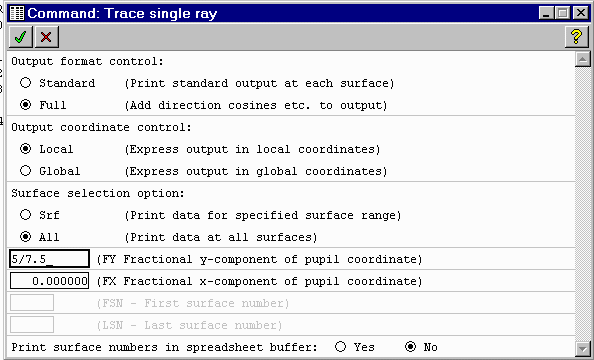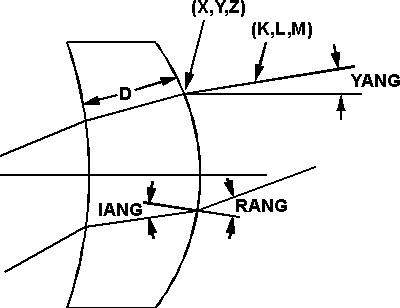 OSLO - Ray Trace
OSLO - Ray Trace OSLO - Ray Trace
OSLO - Ray TraceThis section shows how to trace a single ray through a lens system.

For this example the object point is on the optic axis at infinity. Specify the ray height at the first reference surface (entrance pupil) in fractional coordinates. The reference height is 7.5 mm. If we want the ray to intersect at a height of 5 mm, we would enter 5.5/7.5 for FY, as shown.
We have chosen to list direction cosines and to generate information for all surfaces.
Example output is shown below:
*TRACE RAY - LOCAL COORDINATES
SRF Y/L X/K Z/M YANG/IANG XANG/RANG D/OPL
1 5.000000 -- 0.424190 -3.321783 -- 0.424190
-0.057944 -- 0.998320 9.698502 6.376720 0.424190
2 4.845716 -- -0.517631 -1.844329 -- 2.662652
-0.032184 -- 0.999482 15.516482 14.039028 4.462902
3 4.769901 -- -0.163170 -5.750525 -- 2.355681
-0.100197 -- 0.994968 5.762786 9.668983 8.403244
4 4.753469 -- -- -5.750525 -- 0.163996
-0.100197 -- 0.994968 5.750525 5.750525 8.567239
PUPIL FY FX OPD
0.666667 -- -404.465670
The standard output from the trace_ray command gives the (X, Y, Z) coordinates of the ray on each surface, the ray angles YANG and XANG (in degrees), and the distance D along the ray from the previous surface to the current surface. The full output shows, in addition, the direction cosines (K, L, M), the angles of incidence and refraction IANG and RANG (in degrees), and the optical path length from the entrance sphere up to the current surface.

Maintained by John Loomis, last updated 23 Sept 1998